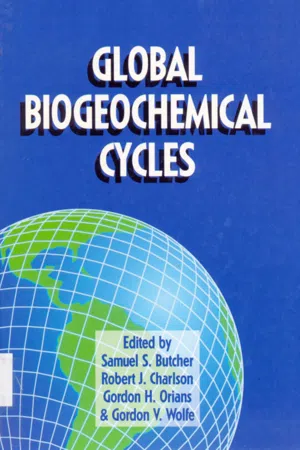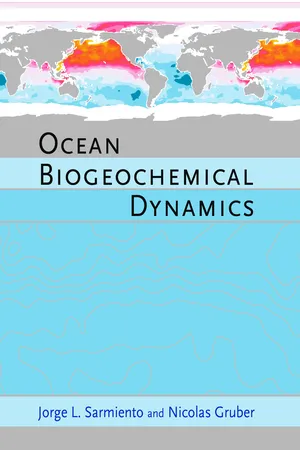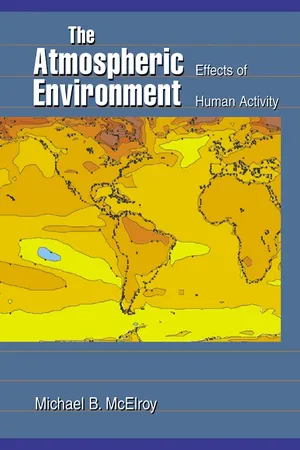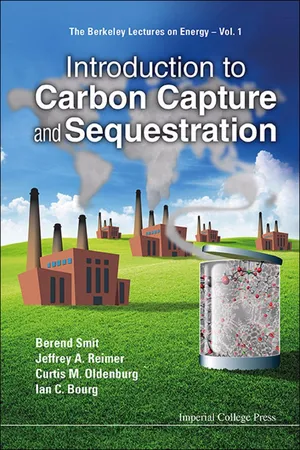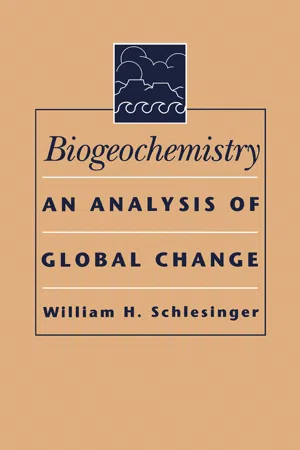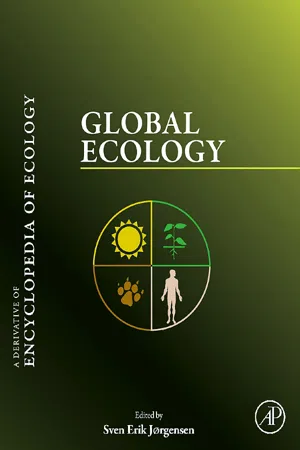Geography
Carbon Cycle
The carbon cycle is the process through which carbon is exchanged between the atmosphere, oceans, biosphere, and geosphere. It involves various processes such as photosynthesis, respiration, decomposition, and combustion, which contribute to the movement of carbon in different forms. This cycle plays a crucial role in regulating Earth's climate and sustaining life on the planet.
Written by Perlego with AI-assistance
Related key terms
1 of 5
10 Key excerpts on "Carbon Cycle"
- eBook - PDF
- Butcher(Author)
- 1992(Publication Date)
- Academic Press(Publisher)
11 The Global Carbon Cycle Kim Holmen 11.1 Introduction Although many elements are essential to living matter, carbon is the key element of life on Earth. The carbon atom's ability to form long covalent chains and rings is the foundation of organic chemistry and biochemistry. The biogeochemical cycle of carbon is necessarily very complex, since it includes all life forms on Earth as well as the inorganic carbon reser-voirs and the links between them. Despite being a complicated elemental cycle, it is extensively studied and, to date, probably the best understood. Lately, the possibility of global climatic changes brought about by the greenhouse effect of fossil fuel CO 2 in the atmosphere has also prompted much carbon-related research. There are many review articles and books about the Carbon Cycle available with varying degrees of detail and points of emphasis (e.g. Bolin, 1970a, b; Keeling, 1973; Woodwell and Pecan, 1973; Wood-well, 1978; Bolin et al., 1979; Revelle, 1982; Bolin and Cook, 1983; Degens et al., 1984). This chapter is an attempt to give an account of the fundamental aspects of the Carbon Cycle from a global perspective. An outline of the details we shall encounter is shown in Fig. 11-1. After a presentation of the main characteristics of carbon on Earth, four sections follow: a section about the carbon reservoirs within the atmosphere, the hydrosphere, the bio-sphere, and the lithosphere; a section covering the most important fluxes between the reservoirs; a section giving brief accounts of selected models of the Carbon Cycle; and a final section describing cultural influences on the Carbon Cycle today. The relevant time-scales vary over many orders of magnitude, from millions of years for processes controlled by the movement of the Earth's crust, to day and even seconds for processes related to air-sea exchange and photosynthesis. Depending on the problem studied, models only include processes that work on similar time-scales. - eBook - ePub
- Andrew H. Knoll, Don E. Canfield, Kurt O. Konhauser, Andrew H. Knoll, Don E. Canfield, Kurt O. Konhauser(Authors)
- 2012(Publication Date)
- Wiley-Blackwell(Publisher)
3 THE GLOBAL Carbon Cycle: GEOLOGICAL PROCESSESKlaus Wallmann1and Giovanni Aloisi1,21 Leibniz Institute for Marine Sciences (IFM-GEOMAR), Wischhofstrasse, 1–3; 24148, Kiel, Germany 2 UMR CNRS 7159LOCEAN, Universite Pierre et Marie Curie, Paris, France3.1 Introduction
In this chapter, we will discuss the geological Carbon Cycle including all processes controlling the distribution of carbon between the interior of the Earth, the lithosphere, the hydrosphere and the atmosphere (Fig. 3.1 , Table 3.1 ). Our discussion focuses on the geochemical evolution of carbon inventories and fluxes on a multi-million year timescale. We will first address the magnitude of carbon fluxes in the pre-human Holocene and then over the last million years. We next examine the feedbacks stabilizing the distribution of carbon on our planet and present a balanced geological Carbon Cycle. Subsequently, we explore proxies and models to explain how carbon cycling may have changed over the Earth’s geological history in parallel with its biological and geological evolution.3.2 Organic carbon cycling
Land plants and phytoplankton use solar energy to convert atmospheric CO2 into biomass via photosynthesis. The overall stoichiometry of photosynthesis can be expressed as:(3.1)where the simple carbohydrate C(H2 O) represents organic carbon formed by this process. Molecular oxygen (O2 ) is released as an important by-product of this reaction (see Chapter 7). Most of the biomass formed by photosynthesis, however, is rapidly consumed by microorganisms living in soils and in the oceans. Just as humans do, they use the biomass as an energy resource and recycle CO2 into the atmosphere (electron acceptors other than O2 are also used to oxidize organic matter as described below):(3.2)This respiration process consumes more than 99% of the biomass produced by photosynthesis both on land and in the sea (Table 3.2 ). On land, the remaining biomass accumulates in living vegetation, soils and detritus, but this is only transient, as most terrestrial organic matter is finally exported into the oceans by rivers in dissolved or particulate form (IPCC, 2007). Overall, approximately 4–5 Tmol yr− 1 - eBook - PDF
- Jorge L. Sarmiento, Nicolas Gruber(Authors)
- 2013(Publication Date)
- Princeton University Press(Publisher)
Chapter 10 Carbon Cycle, CO 2 , and Climate Throughout most of this book, our discussions have focused on the steady-state characteristics of the cycles of biogeochemically important elements in the ocean. However, as more about the past behavior of these cy- cles was learned, we have to come to realize that these cycles have seldom been in a ‘‘true’’ steady state. It appears that variability is as much a fundamental prop- erty of these biogeochemical cycles as it is a property of the climate system in general (see discussion in section 2.5). In this last chapter, we explore the variability of these cycles on a range of timescales, from a few years to several hundred thousand years. In trying to un- derstand the mechanisms that give rise to these varia- tions, we will apply many of the tools and concepts that we have learned in the previous nine chapters. We will focus on the Carbon Cycle, because of its central role in biogeochemical cycling and its interaction with climate as a result of the greenhouse gas properties of CO 2 in the atmosphere. This cycle is also of particular interest given the fact that humankind has began to perturb the global Carbon Cycle dramatically and likely will continue to do so. 10.1 Introduction A very good indicator for the state of the global Carbon Cycle is atmospheric CO 2 , since it represents the con- centration of a relatively small reservoir that acts as a conveyor for the exchange of carbon between the two other important reservoirs of the global Carbon Cycle: the terrestrial biosphere, including the soils, and the ocean, including its sediments (figure 10.1.1). The amount of CO 2 in the atmosphere is also small com- pared with the gross exchange fluxes between it and the ocean and terrestrial biosphere, as reflected in the short residence time of about 6 to 8 years for CO 2 in the atmosphere with respect to these exchange fluxes. - eBook - PDF
The Atmospheric Environment
Effects of Human Activity
- Michael B. Mcelroy(Author)
- 2021(Publication Date)
- Princeton University Press(Publisher)
The balance, as we shall see, must have been transferred either to the ocean or to the ter- restrial biosphere, or it must have been sequestered in soils. We use the term biosphere here to refer generally to the living 142 The Carbon Cycle portion of the terrestrial system and primarily to the carbon content of trees and plants. Despite their overriding impor- tance in the cycling of chemical elements, animals and mi- crobes account for a negligibly small fraction of the total car- bon content of the biosphere. The term soil as used here refers to the composite reservoir of carbon stored below ground. The second notable feature of the results in Figures 11.1 and 11.2 is the sawtooth pattern evident for the variation of CO 2 over the course of a year. The abundance of CO 2 in the atmosphere at Mauna Loa decreases during spring and sum- mer, rising during autumn and winter. This pattern reflects the role of photosynthesis as a sink for atmospheric CO 2 during spring and summer, and the balancing effects of res- piration and decay returning CO 2 to the air during autumn and winter. The amplitude of the seasonal signal is even larger at Point Barrow, Alaska, as indicated in Figure 11.4, reflecting the closer proximity of this site to a greater con- centration of deciduous plants. It is relatively small at the South Pole, as might be expected given the remote nature of this station and the comparative absence of vegetation, es- pecially deciduous plants, in the Southern Hemisphere. The data in Figures 11.1, 11.2, and 11.4 provide unambiguous evidence for the importance of vegetation and soils in the budget of atmospheric CO 2 . This chapter concerns the processes regulating the con- centration of CO 2 in the atmosphere. Ultimately we aim to understand the fate of CO 2 introduced to the atmosphere by the burning of fossil fuels. - eBook - PDF
Atmospheric Chemistry and Physics
From Air Pollution to Climate Change
- John H. Seinfeld, Spyros N. Pandis(Authors)
- 2016(Publication Date)
- Wiley(Publisher)
Nonetheless, the important features of the Carbon Cycle, such as the percentage of carbon emissions remaining in the atmosphere, are re fl ected in most models. FIGURE 22.6 Percentage of initial atmospheric CO 2 perturbation remaining in the atmosphere in response to an idealized instantaneous pulse in year 0 as calculated by a range of coupled climate – Carbon Cycle models. Solid line is the multimodel mean and the shading is the 2-standard deviation range. Left panel, 100 years; right panel, 1000 years. (IPCC 2013.) 915 THE GLOBAL Carbon Cycle FIGURE 22.7 Decay of a CO 2 excess amount of 5000 PgC emitted into the atmosphere at time zero and its subsequent redistribution into land and ocean as a function of time, computed by coupled carbon-cycle climate models. The size of the bands indicates the carbon uptake by the respective reservoir. The fi rst two panels show the multimodel mean from a model intercomparison project (Joos et al. 2013). The last panel shows the longer-term redistribution, including ocean dissolution of carbonaceous sediments as com-puted by an Earth System model. (IPCC 2013.) Carbon is naturally contained in all of Earth ’ s compartments; the global Carbon Cycle is a description of how carbon moves among those compartments in response to perturbations, such as emissions from fossil fuel burning and deforestation. Compartmental models of the global Carbon Cycle provide a means to simulate the fl ux of carbon between the various reservoirs and to estimate future levels corresponding to different CO 2 emission scenarios. Figure 22.8 shows a six-compartment model of the Carbon Cycle due to Schmitz (2002). The quantities shown in parentheses in each compartment are estimates of the preindustrial ( ∼ 1850) amount of carbon, indicated by the M i symbols, measured in petagrams (Pg C) in each reservoir. - eBook - PDF
Biogeochemistry
An Analysis of Global Change
- William H Schlesinger(Author)
- 2012(Publication Date)
- Academic Press(Publisher)
Temporal Perspectives of the Carbon Cycle Studies of the biogeochemistry of carbon must begin with the origin of carbon as an element and with theories that explain its differential abun-dance on the planets (Chapter 2). These are non-steady-state views; the carbon content of the planet grows with the receipt of planetisimals and meteorites, and the atmospheric content increases as volcanoes release C 0 2 . T h e history of atmospheric C 0 2 is a good index of the global Carbon Cycle, since the atmosphere is directly linked to most other compartments, including the biosphere, and rapidly responds to changes in their func-tion (Fig. 11.1). T h e oldest geologic sediments suggest that atmospheric C 0 2 may have been as high as 3 % on the primitive Earth, providing a substantial greenhouse effect during a time of low solar output (Walker 1985a). Even today, 350 p p m of atmospheric C 0 2 raises the surface temperature of the Earth above freezing and is essential for the persis-tence of the biosphere (Ramanathan 1988). A comparison among the planets provides one end to a spectrum of views of the Carbon Cycle. How did the Earth avoid the runaway green-house effect that has raised the surface temperature on Venus far above that conducive for life (Chapter 2)? This longest view suggests some stabilizing, or steady-state components, in the global Carbon Cycle on Earth. One mechanism for maintaining relatively constant, low concentra-tions of atmospheric C 0 2 is through its interactions with the cycle of carbonate and silicate rocks (Fig. 2.8). Using a long-term model for the Earth, Berner et al. (1983) suggest that this cycle has maintained the concentrations of atmospheric C 0 2 between 200 and 6000 p p m for the last 100 million years (Berner and Lasaga 1989). O n Mars, where this cycle has slowed or stopped, the atmosphere contains a small amount of C 0 2 , and the planet is cold (Chapter 2). - eBook - ePub
- Berend Smit, Jeffrey A Reimer, Curtis M Oldenburg, Ian C Bourg(Authors)
- 2014(Publication Date)
- ICP(Publisher)
Section 1
Introduction
In Chapter 2 we have seen that the CO2 in the atmosphere plays an important role in regulating the temperature of the earth. It is therefore important to understand the biological, geological, and chemical mechanisms that control CO2 levels in the atmosphere. In this chapter, we discuss these mechanisms.Figure 3.1.1 illustrates the various mechanisms by which carbon is exchanged between different regions of the earth [3.1]. Photosynthesis takes CO2 from the atmosphere and converts the carbon into biomass. The inverse process, the decomposition of biomass stored in the soils, converts the carbon of the biomass into CO2 which is subsequently released into the atmosphere. If we look carefully at the figure, we see many different mechanisms that transfer carbon from one chemical state to another or transfer carbon from one “reservoir” to another. If we would like to understand how CO2 concentrations in the atmosphere are regulated, we have to elucidate the interactions between the different carbon reservoirs. For example, an increased atmospheric CO2 concentration will stimulate biosynthesis and hence increase the amount of biomass. Similarly, an increase in atmospheric CO2 will increase the uptake of CO2 in the oceans. Quantification of this Carbon Cycle should answer questions such as: how much of the anthropogenic CO2 that is added to the atmosphere will end up in biomass or in the oceans?To answer this and other questions we will look at the earth from a systems point of view. The idea of system analysis is to describe a cell, organism, or a chemical factory as a system of mathematical objects that interact with each other. This sounds abstract, but we will see that this approach gives us interesting insights. In the case of the Carbon Cycle, the first step is to quantify the different reservoirs of carbon. - eBook - PDF
Biogeochemistry
An Analysis of Global Change
- William H. Schlesinger(Author)
- 2012(Publication Date)
- Academic Press(Publisher)
In the absence of methanogen- 11. The Global Carbon Cycle 321 Atmosphere 3.8 χ ΙΟ 7 matter 4.4 χ ΙΟ 5 Weathering 16 Burial 16 Reduced constituents of the crust 8 x 10 9 figure 11.5 A simple model for the global biogeochemical cycle of 0 2 . Data are expressed in units of 1 0 12 moles of 0 2 per year or the equivalent amount of reduced compounds. Note that a small misbalance in the ratio of photosynthesis to respiration can result in a net storage of reduced organic materials in the crust and an accumulation of 0 2 in the atmo-sphere. From Walker (1980). sis, the burial of organic carbon would be greater and the atmospheric content of 0 2 might be slightly higher (Watson et al. 1978, K u m p and Garrels 1986). It is also entertaining to speculate whether the Carbon Cycle on Earth drives the oxygen cycle, or vice versa. Over geologic time, the answer is obvious: the conditions on our neighboring planets are ample evidence that 0 2 is derived from life. Now, however, the cycles are inextricably linked, and the discussion seems merely philosophical. T h e metabolism of eukaryotic organisms, including humans, depends on the flow of elec-trons from reduced organic molecules to oxygen. Recommended Reading Houghton, J.T., G.T.Jenkins, and J.J. Ephraums. (eds.). 1990 Climate Change: T h e IPCC Scientific Assessment. Cambridge University Press, Cambridge. Trabalka, J.R. (ed.). 1985. Atmospheric Carbon Dioxide and the Global Carbon Cycle. U.S f Department of Energy, Washington, D.C. Woodwell, G.M. (ed.). 1984. T h e Role of Terrestrial Vegetation in the Global Carbon Cycle: Measurement by Remote Sensing. Wiley, New York. - eBook - PDF
- Sven Erik Jørgensen(Author)
- 2010(Publication Date)
- Academic Press(Publisher)
Carbon Fluxes in Terrestrial Ecosystems All three CO 2 -controlling processes (ocean soaking, photosynthesis, and carbonate formation) play an impor-tant role in maintaining equilibrium in the biosphere– atmosphere–hydrosphere system. The photosynthetic process is of great importance for living plants and micro-organisms. The difference between total photosynthesis and respiration processes is defined as ‘net primary pro-duction’, NPP. The global NPP distribution in the Earth’s major ecological zones is shown in Table 3 . Marine biota 3 Surface ocean 1020 Fossil fuels and cement production DOC <700 Intermediate and deep ocean 38 100 Surface sediment 150 6 4 90 5.5 6 0.2 91.6 100 Vegetation 610 Soils and detritus 1580 2190 Atmosphere 750 60 1.6 0.5 40 50 92 Global net primary production and respiration 81.4 Changing land use Figure 3 The global Carbon Cycle, showing the reservoirs (in 10 9 t yr 1 ) relevant to the anthropogenic perturbation as annual averages over the period 1980–89. Table 2 The major global carbon reservoirs Reservoirs C (10 9 t) Atmosphere, CO 2 1680 Global land Vegetable biomass prior to human activity (estimates) 1150 Present natural vegetable biomass 900 Soil cover Forest litterfall 100 Peat 250 Humus 1200 Total 1550 Ocean Photosynthetic organisms 1.7 Consumers 2.3 Soluble and dispersed organic matter 2100 Hydrocarbonate ions in solution 38 539 Total 40 643 Earth’s crust Sedimentary shell, C o 15 000 000 Sedimentary shell, C c 81 000 000 Continental granite layer, C o 4 000 000 Continental granite layer, C c 18 000 000 Total 118 000 000 Total present global C mass 118 044 773 126 Carbon Cycle Oceans, despite their much larger surface area, con-tribute much less than half of the global NPP. The reason is related to high nutrient deficiency in surface waters, which limits the photosynthesis process. - eBook - PDF
- Amrita Pandey(Author)
- 2019(Publication Date)
- Delve Publishing(Publisher)
These nitrogenous compounds also get utilized by the aquatic plants, accumulated on the earth’s surface as organic sediments and some are evaporated into the atmosphere. The nitrogen cycle is mostly completed when different forms of denitrifying bacteria and other microorganisms convert the nitrates and nitrites to ammonia, nitrogen oxides and nitrogen which is again released into the atmosphere. 1.4.2. Carbon Cycle Carbon is known to be present in the atmosphere in the form of carbon dioxide and the elemental carbon dioxide is absorbed by the plants to fulfill a variety of their processes related to the conversion of carbohydrates into the energy by a process called as photosynthesis. Earth Systems and Environment 18 The Carbon Cycle includes the consumption of the food by the living organisms and then this food is metabolized by several different living organisms and the carbon dioxide is exhaled by the process of respiration. Figure 1.3: Representation of Carbon Cycle. Source: https://live.staticflickr.com/8486/8265010034_cc08a75056_z.jpg The carbon dioxide that is absorbed by the plants to produce food is returned back to the atmosphere through respiration and as living organisms exhale a lot of carbon dioxide is released into the system. There are several living organisms that die every day and the decomposition of these living organisms is known to release a large quantity of carbon into the atmosphere. Plants, animals and microorganisms are important parts of the Carbon Cycle as they actively participate in the exchange of carbon through several metabolic processes. Soil is another important storehouse of carbon along with several living organisms. The atmospheric carbon dioxide is known to be soluble in water and this forms carbonic acid and this carbonic acid gets converted into bicarbonate and carbonate ions which generally form salts.
Index pages curate the most relevant extracts from our library of academic textbooks. They’ve been created using an in-house natural language model (NLM), each adding context and meaning to key research topics.
